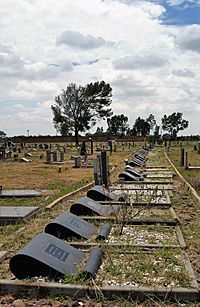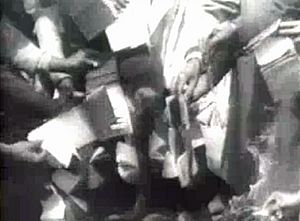Sharpeville massacre facts for kids
Quick facts for kids Sharpeville massacre |
|
|---|---|

The row of graves of the 69 people killed by police at the Sharpeville Police Station on 21 March 1960.
|
|
| Location | Sharpeville, Transvaal Province, South Africa |
| Date | 21 March 1960 |
| Deaths | 69 |
|
Non-fatal injuries
|
180 |
The Sharpeville massacre happened on 21 March 1960. It took place at a police station in Sharpeville, a township in South Africa. A township was a special area where Black South Africans were forced to live.
About 7,000 people were protesting against unfair "pass laws." These laws made it very hard for Black South Africans to move around and find work. The crowd gathered near the police station. Some people say the crowd was peaceful. Others say they threw stones at the police. The police then opened fire on the crowd. Tear gas had not worked to make them leave. In total, 249 people were hurt or killed. This included 29 children. 69 people died and 180 were injured. Some people were shot in the back as they tried to run away.
A photographer named Ian Berry took pictures of the event. He first thought the police were firing fake bullets. Today, 21 March is a public holiday in South Africa. It is called Human Rights Day. It remembers the Sharpeville massacre and celebrates human rights.
Contents
Life in Sharpeville Before the Massacre
Sharpeville was built in 1943. It was meant to replace another crowded township called Topville. Many people in Topville were getting sick, especially with pneumonia. Because of this, about 10,000 Black Africans were forced to move to Sharpeville starting in 1958.
Life in Sharpeville was tough. Many people did not have jobs. There were also high crime rates. Young people sometimes joined gangs instead of going to school. A new police station was built in Sharpeville. The police there were very strict. They often checked people's passes. They also sent away people who were living there without permission.
Why the Protest Happened
For a long time, South African governments had rules to control where Black South Africans could live. These were called "pass laws." They were meant to control where people moved and worked. In the 1950s, these laws became even stricter.
Under the National Party government, Black people in cities had to follow strict rules. This system was called apartheid. It meant people were separated by race. If you were over 16, you had to carry a "passbook." This book had your ID, work permits, employer details, and personal history.
By 1959–1960, these pass laws also included women. The government used these laws to keep people separated. They also used them to arrest people who spoke out against the government.
Two main groups were fighting against these unfair laws. One was the African National Congress (ANC). The other was the Pan-Africanist Congress (PAC). The ANC planned to start protests on 31 March 1960. But the PAC, led by Robert Sobukwe, wanted to act first. They started their protest ten days earlier, on 21 March. They believed they could win the fight against the pass laws.
The Day of the Massacre
On 21 March 1960, a large group of people gathered at the local police station. There were between 5,000 and 10,000 people. They offered to be arrested for not carrying their passbooks. The police in Sharpeville knew a protest might happen. They had already turned away smaller groups the night before.
The PAC worked hard to get many people to join the protest. They handed out flyers. They also told people not to go to work that day. Many people came to support the protest on their own. But there is also proof that the PAC made some people come. They cut telephone lines into Sharpeville. They also stopped bus drivers from doing their routes.
By 10:00 AM, a huge crowd had gathered. At first, the mood was calm and even happy. There were fewer than 20 police officers at the station. Later, the crowd grew to about 20,000 people. The mood became "ugly." About 130 more police officers arrived. They had four armored vehicles with them. The police carried guns, including machine guns and rifles. There was no sign that anyone in the crowd had weapons, except for stones.
Jets flew very low over the crowd. They came within 30 meters of the ground. This was an attempt to make the crowd scatter. The protesters reacted by throwing stones. Three policemen were hit. The crowd also rushed toward the police barriers. Police tried to use tear gas to push them back. But it did not work. The police then used their batons. Around 1:00 PM, the police tried to arrest a protester. The crowd pushed forward. The police then started shooting.
Deaths and Injuries
The official numbers say that 69 people were killed. This included 8 women and 10 children. 180 people were injured. This included 31 women and 19 children. Many people were shot in the back as they ran away. Some of them became paralyzed.
The victims were buried together in a large ceremony. Religious leaders led the service.
Why the Police Fired
Police reports from 1960 said that young and new police officers panicked. They started shooting without orders. This caused a chain reaction that lasted about 40 seconds. Few of the police officers had been trained for crowd control. Some had been working for over 24 hours without a break.
A police commander, Lieutenant Colonel Pienaar, said something important. He stated that "the native mentality does not allow them to gather for a peaceful demonstration. For them to gather means violence." He also said he did not order anyone to shoot.
However, other information was given to the Truth and Reconciliation Commission. This information suggested that the decision to shoot at Sharpeville was planned. It showed that the shooting was more than just scared police officers losing control.
Remembering Sharpeville
Since 1994, 21 March has been celebrated as Human Rights Day in South Africa.
Sharpeville was chosen by President Nelson Mandela for a very important event. On 10 December 1996, he signed the new Constitution of South Africa into law there.
In 1998, the Truth and Reconciliation Commission (TRC) looked into the event. They found that the police used too much force. They said it was not needed to stop a gathering of unarmed people. This was a "gross human rights violation."
On 21 March 2002, a memorial was opened in Sharpeville. It was the 42nd anniversary of the massacre. Former President Nelson Mandela opened it. It is part of the Sharpeville Human Rights Precinct.
International Day for Ending Racism
UNESCO marks 21 March each year as the International Day for the Elimination of Racial Discrimination. This day remembers the Sharpeville massacre.
See also
 In Spanish: Matanza de Sharpeville para niños
In Spanish: Matanza de Sharpeville para niños
- List of massacres in South Africa
- Human Rights Day
- Apartheid
- Nelson Mandela


